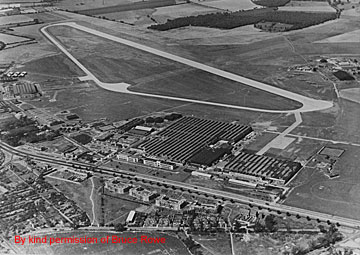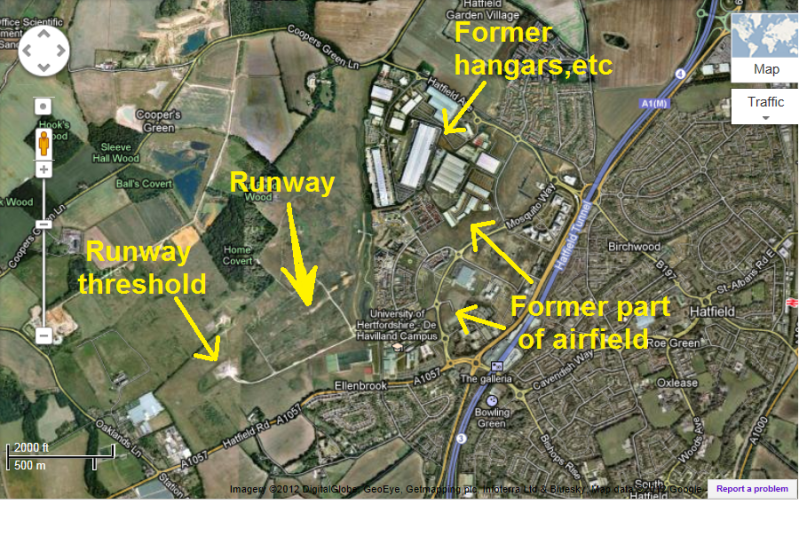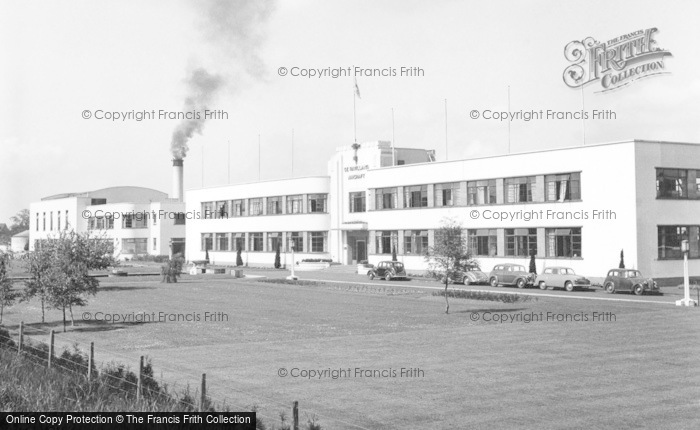This was a wondrous explore through the countryside and off the beaten track. It involved me parking my car up near my former work place and walking through Cuffley through to Hatfield and walking back. It was almost a 24 mile walk and tested me to the maximum. I think i bit off more than i could chew here but it was worth the explore. My feet told me another story though as i clearly had the wrong footwear on and later on in the day it started to rain which made matters worse for me.
I was stopped by the police twice during this trip. Once when i was photographing the De Havilland buildings (one was a police station and the other a courthouse), and almost back to my car late at night, by a copper who followed me and did a PNC check on my driving licence. I still had 7 miles of walking to go at that point and was never given a lift!
Interspersed in this report will be a mixture of photos that take my eye and eventually ending up at the De Havilland site. I chose to pick up some pillboxes on the back of Cuffley golf course first and complete the line of connecting Pillboxes that run behind the housing estate and out into Cuffley itself. It was a real mixture of tough going and very pleasant scenery interspersed with the usual break for food and a drink. The real goal was the De Havilland site itself. This can be arranged as a formal guided tuor but i would rather take my own pace at exploring and despite the interest from the Police and the pain involved- it was certainly worth the experience.
The de Havilland Aircraft Company was a British aviation manufacturer founded in 1920 when Airco, of which Geoffrey de Havilland had been chief designer, was sold to BSA by the owner George Holt Thomas. De Havilland then set up a company under his name in September of that year at Stag Lane Aerodrome in Edgware, near London. The company later moved to Hatfield in Hertfordshire. De Havilland Aircraft Company was responsible for producing the first passenger jet and other innovative aircraft.
Initially, de Havilland concentrated on single and two-seat biplanes, essentially continuing the DH line of aircraft built by Airco, but powered by de Havilland's own Gipsy engines. These included the Gipsy and Tiger Moths. These aircraft set many aviation records, many piloted by de Havilland himself. Amy Johnson flew solo from England to Australia in a Gipsy Moth in 1930.
The Moth line of aircraft continued with the more refined (and enclosed) Hornet Moth and Moth Minor, the latter being a low-wing monoplane constructed of wood.
I was stopped by the police twice during this trip. Once when i was photographing the De Havilland buildings (one was a police station and the other a courthouse), and almost back to my car late at night, by a copper who followed me and did a PNC check on my driving licence. I still had 7 miles of walking to go at that point and was never given a lift!
Interspersed in this report will be a mixture of photos that take my eye and eventually ending up at the De Havilland site. I chose to pick up some pillboxes on the back of Cuffley golf course first and complete the line of connecting Pillboxes that run behind the housing estate and out into Cuffley itself. It was a real mixture of tough going and very pleasant scenery interspersed with the usual break for food and a drink. The real goal was the De Havilland site itself. This can be arranged as a formal guided tuor but i would rather take my own pace at exploring and despite the interest from the Police and the pain involved- it was certainly worth the experience.
The de Havilland Aircraft Company
The de Havilland Aircraft Company was a British aviation manufacturer founded in 1920 when Airco, of which Geoffrey de Havilland had been chief designer, was sold to BSA by the owner George Holt Thomas. De Havilland then set up a company under his name in September of that year at Stag Lane Aerodrome in Edgware, near London. The company later moved to Hatfield in Hertfordshire. De Havilland Aircraft Company was responsible for producing the first passenger jet and other innovative aircraft.
Initially, de Havilland concentrated on single and two-seat biplanes, essentially continuing the DH line of aircraft built by Airco, but powered by de Havilland's own Gipsy engines. These included the Gipsy and Tiger Moths. These aircraft set many aviation records, many piloted by de Havilland himself. Amy Johnson flew solo from England to Australia in a Gipsy Moth in 1930.
The Moth line of aircraft continued with the more refined (and enclosed) Hornet Moth and Moth Minor, the latter being a low-wing monoplane constructed of wood.
Interior of de Havilland aircraft factory, Rongotai, Wellington, 1939 or 1940


Mosquito aircraft in various stages of production at Hatfield.











Onto the explore itself.




























































































































































Onto the explore itself.






PILLBOX: S0012134
Initially quite difficult to find and sat behind a high bank of earth in thick undergrowth.
Cheshunt Park Farm - field no. 3064, about 210 yards SSW of SW corner of moat in Hell Wood.








PILLBOX (TYPE FW3/22): S0000584
Fully sealed off and used as a bat sanctuary.








ANTI TANK BLOCK: S0000585



A pillbox i had previously visited by entering the farm with permission. This is the approach from the other side of the farm. The LAA pit is fully sealed and capped. The pillbox is totally sealed off.
PILLBOX (TYPE FW3/27): S0000583
In the grounds of Cheshunt Park at the boundary with land of Cheshunt Park Farm.



Having visited the pillbox previously i really needed to step on it to get to Hatfield.

Remnants of an old tractor in the gloom.


PILLBOX (TYPE FW3/22): S0005055
By now the light levels were falling quite rapidly so i made a decision to photograph the internals first, rest up and get back to this pillbox very early in the morning for the externals before carrying on my trek. Sat in the corner of a field and next to a vehicle storage area, it is always a seemingly fine line between accessing these sites and not looking too suspicious.
St. Lawrence Farm, East of Newgate Street and railway line.



Clean interior walls except it was partially flooded and strewn with the usual rubbish.







PILLBOX (TYPE FW3/22): S0005054
Cutting across the field and somehow eventually finding my way across the very wide and deep ditch to the rear of this property, i walked the outside of the manicured lawns and got to this rather quaint pillbox. Originally it would have offered partial coverage of the rail bridge at the foot of Darnicle Hill and is part of the connective line of defences in this area. The AT blocks at the rail bridge are something else!! but will be covered in another report.


Again a very featureless interior.




Way too early in the morning but it would have been great.




The decimation of families.



PILLBOX (TYPE FW3/24): S0005051
To the rear of Carbone Hill and in a line of defences starting will a pillbox near the road and continuing past a roadblock is this pillbox sat at the rear of the line.








Sat behind the pillbox is another roadblock - the second in this line of defences.
ROADBLOCK: S0005052




Walking back up to the road - the other road block.
ROADBLOCK: S0005050





Taking in the site of the first Destroyed German Zeppelin in WW1
The Ridgeway - Cuffley.






Heading back out on the walk to Hatfield - a vintage tractor.














Finally...................

Sir Geoffrey de Havilland founded The de Havilland Aircraft Company Limited on 25 September 1920, ten days before the company took up residence at Stag Lane, Edgware. By the time they bought the land and opened an aerodrome in Hatfield, in 1930, de Havilland was a successful global company. But it was taken over by Hawker Siddeley in 1960, who absorbed the company and dropped the de Havilland name in 1963. In 1977 Hawker Siddeley become part of British Aerospace, but many people in Hatfield today still refer to the airfield site as de Havillands. Aviation may have flown away but the de Havilland name lives on, and there are other reminders of Hatfield's aviation glory days.
Sir Geoffrey de Havilland statue – sculpted by Keith Maddison, who also created the two flanking plaques bearing de Havilland aircraft. The statue, which was unveiled by the Duke of Edinburgh in July 1997, is located on the University of Hertfordshire's College Lane Campus. The University itself is a reminder of de Havillands, as it origins can be traced back to their technical school.






The de Havilland Aircraft Company logo – on the wall of the two-storey de Havilland Sports and Social Club building, which is also the training HQ for Saracens Rugby Club. The clubhouse was opened by the then UH Chancellor Lord MacLaurin on 26 March 2002. The 2003 painting 'A de Havilland heritage' by Edmund Miller, GAvA member and former de Havilland employee, adorns the entrance foyer.


Out onto the perimeter track to the test runway. Very little remains of the original runway.

Airfield Radio Beacon / Aerial Lighthouse – following the opening of Ellenbrook Fields, now visible from close quarters (but not too close please, as it is now a barn owl roost). Not to be confused with the original airfield beacon, which literally was an aerial lighthouse (due to be installed again at Hatfield).






The blue cross marks the spot i am standing at.

The marker posts for the edges of the runway.

The original control tower and hangar.
The Flight Test Hangar is the only remaining hangar at Hatfield. When it was built in the 1950s it was the world's largest aluminium structure. However, it is more than just a hangar – a control tower, offices and fire station were added shortly afterwards. Granted Grade II listed building status, in September 1992, there have been suggestions that its survival is due to mistaken identity – it was confused with the Comet Hangar, where the world's first commercial jet aircraft was built.




The fire station.








Part of the original Art Deco complex.
Canteen Block – also dating back to 1934, now the Hatfield Police Station, which has been joined to the old HQ building to form part of a Police and Courts complex. During WWII, artist Frank Wootton painted a mural on the wall of the workers canteen (managers had separate facilities upstairs). Sadly, this has not survived although a picture of it was published in The Times.



Entrance Guardhouse – another surviving part of the 1934 headquarters complex. It has been restored but currently is not used.



Personnel Block – the last of the four 1934 survivors. Now used as a fastfood outlet.





The Comet Hotel and Comet Racer model – opened in 1936, and a tribute to the DH.88 Comet Racer G-ACSS that won the 1934 MacRobertson England-Australia Air Race. The hotel was designed along the lines of an aeroplane with the 'cockpit' bar and 'wings'. Alex Henshaw celebrated winning the 1938 King's Cup Air Race here.





The courthouse.
The de Havilland Aircraft Company headquarters building – designed by the firm of James M Monro & Son of Glasgow, it originally opened in 1934. Now part of a Police and Court complex. Sadly, nothing remains of the clubhouse, beacon, swimming pool and sports courts that were the first structures on the site. They were demolished as the factory expanded.








Finally having covered the site, and having been stopped by the Police outside The Courthouse, after producing legitimate evidence that i was documenting an historical site, i made my way back to Waltham Abbey. My feet were indeed in a bad way.

Thanks for viewing the report.

No comments:
Post a Comment